Types of Silver: The Best Type of Silver for Your Jewellery
Silver has been treasured for centuries, admired for its beauty, versatility, and elegance. Whether you're buying jewellery for a special occasion, creating your own designs, or simply curious, understanding the various types of silver for jewellery is essential.
Each type of silver has its own unique qualities, benefits, and potential drawbacks, making some better suited for jewellery than others.
What is Silver?
Silver is a precious metal known for its lustrous appearance and remarkable malleability. Found naturally in ores and refined for various uses, silver is a staple in jewellery-making. However, pure silver is rarely used in its raw form due to its softness, which makes it prone to bending or scratching.
Instead, silver is often alloyed with other metals to increase its strength and durability.
1. Fine Silver
Fine silver is defined as silver that possesses a purity level of 99.9%. Often marked with ".999," this type of silver is nearly pure, making it softer than other forms. It has a bright white lustre and is resistant to tarnish, making it an excellent choice for minimalist jewellery or pieces that won't endure heavy wear.
Advantages of Fine Silver
- Hypoallergenic and ideal for sensitive skin.
- Resistant to tarnish, maintaining its shine longer.
- Eco-friendly and often recycled for sustainable jewellery.
Drawbacks of Fine Silver
- Softness makes it unsuitable for intricate designs or everyday wear.
- Can easily lose shape under pressure.
Understand the difference between silver vs sterling silver before you buy.
2. 925 Sterling Silver
Sterling silver is the most popular choice for jewellery due to its perfect balance between beauty and durability. Composed of 92.5% silver and 7.5% other metals (usually copper), it’s marked with ".925."
Advantages of Sterling Silver
- Stronger than fine silver, making it ideal for rings, bracelets, and necklaces.
- Affordable compared to gold or platinum.
- It can be buffed to bring back its initial lustre.
Drawbacks of Sterling Silver
- Susceptible to tarnishing over time.
- Requires regular maintenance to keep its brilliance.
Learn how to check silver purity before making your next jewellery purchase.
3. Argentium Silver
A modern innovation, Argentium silver is an upgraded version of sterling silver. It contains a higher percentage of silver (93.5% or more) and replaces copper with germanium to enhance tarnish resistance.
Why Choose Argentium Silver?
- Greater resistance to tarnishing compared to standard sterling silver..
- It is hypoallergenic, making it an excellent option for those with sensitive skin..
- Requires less frequent polishing.
Potential Limitations
- Slightly more expensive than traditional sterling silver.
- Less widely available, which may limit design choices.
4. Coin Silver
Coin silver is an older alloy containing 90% silver and 10% other metals. It was historically used in coins but has also been utilised for jewellery. Though less common today, it’s still admired for its unique character.
Advantages
- Durable and tarnish-resistant.
- Offers a vintage aesthetic for antique-style jewellery.
Drawbacks
- Less pure than sterling or fine silver.
- Rarely used in contemporary jewellery-making.
5. Silver-Filled
Silver-filled jewellery is made by bonding a layer of silver to a base metal, such as brass or copper. While more affordable than sterling silver, it’s a cost-effective option for semi-fine jewellery.
Benefits of Silver-Filled Jewellery
- Cheaper than sterling silver.
- Suitable for casual wear or trend-based designs.
Challenges with Silver-Filled
- The silver coating may gradually diminish with time.
- Limited lifespan compared to solid silver pieces.
6. Nickel Silver
Although it bears the name "nickel silver," this material actually contains no silver at all. Instead, it is a blend of nickel, copper, and zinc. Known for its affordability, nickel silver is often used for costume jewellery or experimental designs.
Advantages
- Extremely budget-friendly.
- Durable and versatile for decorative pieces.
Disadvantages
- Contains nickel, which can cause allergic reactions.
- Lacks the intrinsic value of genuine silver.
7. Silver Plating
Silver-plated jewellery involves a thin layer of silver electroplated onto a base metal. While visually appealing, its longevity and value are far lower than solid silver jewellery.
Pros of Silver Plating
- Inexpensive and accessible.
- Great for fashion jewellery.
Cons of Silver Plating
- Prone to chipping and fading.
- Limited durability.
Choosing the Best Type of Silver for Jewellery
Selecting the right silver type depends on your specific needs and preferences. For high-end, everyday pieces, sterling silver is your best bet for gold vermeil jewellery.
For special occasions or lightweight designs, fine silver offers unmatched purity and elegance. Budget-conscious buyers may opt for silver-filled or silver-plated jewellery, though these options have limited longevity.
Explore the surprising benefits of wearing silver for both health and style.
How to Care for Silver Jewellery
Regardless of the type of silver, proper care ensures your jewellery lasts longer and retains its shine:
- Keep it in a sealed, dry container to avoid tarnishing.
- Clean regularly with a soft cloth or silver polish.
- Avoid exposure to harsh chemicals or moisture.
Conclusion
Understanding the different types of silver for jewellery allows you to make informed decisions whether you're buying, gifting, or crafting your own pieces. From the enduring appeal of sterling silver to the contemporary advantages of Argentium, there’s a perfect type of silver for every jewellery lover.
With proper care, your silver pieces can remain beautiful for years, serving as timeless symbols of elegance and craftsmanship.
FAQs
1. How many types of silver are there?
There are several types, including:
- Fine Silver (999)
- Sterling Silver (925)
- Coin Silver (900)
- Britannia Silver (950)
- European grades (like 835, 800, 835, 825, etc.)
2. Which is better, 925 or 999 silver?
999 silver is purer, but 925 silver is more durable for jewellery.
3. Is 825 or 925 silver better?
925 silver is better, higher purity and better quality.
4. Which is better, 925 or 950 silver?
950 silver is purer but softer; 925 is more common for durable items.
5. What is the highest quality silver?
999 Fine Silver (99.9% pure) is the highest quality.
6. Why is 925 silver so cheap?
It’s less pure than fine silver and widely produced, making it more affordable.
7. Which silver is best to buy?
For investment: 999 silver.
For jewellery: 925 sterling silver (good balance of purity and strength).
8. How to check silver purity?
- Look for hallmarks (like 925, 999, etc.).
- Use a silver testing kit or acid test.
- Get it tested by a jeweller.
 Best Seller
Best Seller
 New In
New In
 Necklaces
Necklaces
 Rings
Rings
 Bracelets
Bracelets
 Earrings
Earrings
 Personalized
Personalized
 Mangalsutra
Mangalsutra




































